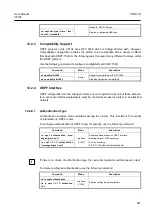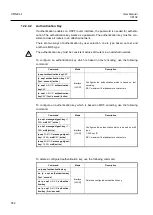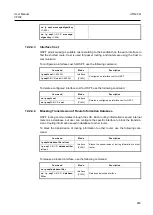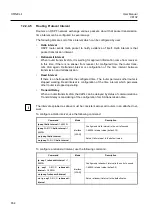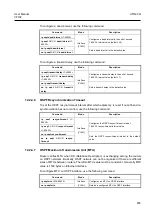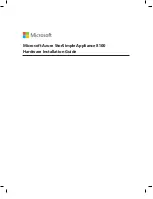
UMN:CLI
User Manual
V8102
640
12.1.22
BGP Filtering through Prefix Lists
Prefix lists were introduced in BGP because they are efficient forms of filtering. Because
they search on the prefix of the address as defined by the administrator, the lookup is
very fast. This is particularly important in the potentially huge routing tables that can be
generated in BGP networks. When you restrict BGP route, prefix list is preferred than ac-
cess list because of the following reason:
•
saves time to search and apply in case of massive filter lists
•
unlimited registration in filter lists
•
easy to use
Before applying prefix list, user should configure prefix list. User can assign a sequence
number to each policy registered in prefix list.
Traffic filtering operation through prefix lists
Filtering through prefix list processes routing information in specific order by applying pol-
icy defined in filter list. It is similar to access list but there are more detail rules as follow.
•
Allows all network information if there is no defined policy in prefix list.
•
Rejects specified network information unless policy applied to network in defined in
prefix list.
•
Distinguishes each policy with the assigned number and applies policy which has
the lowest number when there is more than one policy applied to one network.
Routers search policy in prefix list in order. For faster operation, user can make quick
search list by using
seq
provided from ip prefix-list. In order to view assigned number to
policy, use the
show ip prefix-list
command.
Policies configured by user are automatically assigned number. If you do not configure it,
you should assign number to each policy by using the command,
ip prefix-list seq
<1-
4294967295>.
12.1.22.1
Creating prefix list
To create an entry of IPv4 prefix list, use the following command.
Command
Mode
Description
ip prefix-list WORD
{
deny
|
permit
}
A.B.C.D/M
ge
<0-32>
[
le
<0-32>]
Global
Creates an entry of IPv4 prefix list.
WORD: name of IP prefix list
deny: denies access of packet if conditions are
matched.
permit: permits access of packet if conditions are
matched.
A.B.C.D/M: IPv4 prefix to be matched (e.g.
35.0.0.0/8)
any: any IPv4 prefix to match. (same as 0.0.0.0/0 le
32)
ge: minimum prefix length to be matched
le: maximum prefix length to be matched
0-32: minimum/maximum prefix length
ip prefix-list WORD
{
deny
|
permit
}
A.B.C.D/M
le
<0-32>
[
ge
<0-32>]
ip prefix-list WORD
{
deny
|
permit
}
{
A.B.C.D/M
|
any
}
ip prefix-list WORD description
Writes comments for the prefix list.


























